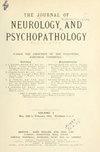PROGNOSIS AND TREATMENT
引用次数: 0
Abstract
OBSERVATIONAL and photographically recorded data showed that flexibilitas cerea, which was present in two stuporose dementia praecox patients, disappeared with the onset of sleep. The motility of these two which was very low during the waking state became much greater during sleep, approaching, though not reaching, the range to be expected from normal sleepers. Three others who exhibited the waxy state during waking hours showed similar relaxation during sleep. Eight non-cataleptic dementia proecox patients showed no marked change between the waking and sleep state in similar records of motility. Their sleeping motility was quite comparable to that of the healthy normal individual. The author's results indicate that studies of experimental catalepsy which attempt to explain the waxy state in dementia precox must provide a ' functional ' mechanism so that the quick reversibility at the onset or end of sleep is accounted for. On the basis of present knowledge, it seems safe to say that activity of either cortical or lower brain centres must be directly or indirectly responsible for the occurrence of flexibilitas cerea in stuporous catatonic dementia praecox patients. Future studies of experimental catalepsy in animals might well include a determination of the effect on the catalepsy of the stimulation of the sleep centres. If the elimination of the catalepsy by such stimulation occurred, it would be a criterion for the identification of experimentally produced catalepsy with that occurring in stuporous dementia preecox patients. C. S. R.预后与治疗
观察和摄影记录的数据显示,在两例睡眠性早发性痴呆患者中存在的脑灵活性随着睡眠的开始而消失。这两个在清醒状态时非常低的运动在睡眠时变得更大,接近,尽管没有达到,正常睡眠者的预期范围。另外三个在清醒时表现出蜡状状态的人在睡眠时也表现出类似的放松。8名非促发性痴呆患者在类似的运动记录中,在清醒状态和睡眠状态之间没有明显的变化。他们的睡眠运动与健康的正常人相当。作者的研究结果表明,试图解释痴呆前期蜡质状态的实验性猝倒研究必须提供一种“功能”机制,以便解释睡眠开始或结束时的快速可逆性。根据目前的知识,似乎可以肯定地说,在昏迷性紧张性早发性痴呆患者中,皮层或大脑下部中心的活动必然直接或间接地导致了脑灵活性的发生。未来对动物实验性猝睡的研究很可能包括确定刺激睡眠中枢对猝睡的影响。如果通过这种刺激消除了猝睡,它将成为鉴别实验产生的猝睡与发生在昏迷性痴呆先兆患者中的猝睡的标准。c.s.r。
本文章由计算机程序翻译,如有差异,请以英文原文为准。
求助全文
约1分钟内获得全文
求助全文

 求助内容:
求助内容: 应助结果提醒方式:
应助结果提醒方式:


